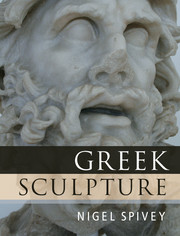Book contents
- Frontmatter
- Dedication
- Contents
- List Of Figures
- Preface
- Note
- 1 Introduction: the Study Of Greek Sculpture
- 2 The Greek Revolution
- 3 Daedalus and the Wings of Technê
- 4 Anathêmata: Gifts for the Gods
- 5 Heroes Apparent
- 6 Temple Stories
- 7 In Search of Pheidias
- 8 Revealing Aphrodite
- 9 Royal Patronage
- 10 Portraits and Personifications
- 11 Graecia Capta
- 12 Afterlife
- Index
5 - Heroes Apparent
Published online by Cambridge University Press: 01 December 2014
- Frontmatter
- Dedication
- Contents
- List Of Figures
- Preface
- Note
- 1 Introduction: the Study Of Greek Sculpture
- 2 The Greek Revolution
- 3 Daedalus and the Wings of Technê
- 4 Anathêmata: Gifts for the Gods
- 5 Heroes Apparent
- 6 Temple Stories
- 7 In Search of Pheidias
- 8 Revealing Aphrodite
- 9 Royal Patronage
- 10 Portraits and Personifications
- 11 Graecia Capta
- 12 Afterlife
- Index
Summary
Of the great and the good
Heroes play the lead roles in Greek mythology and literature; hero-worship was an important element of ancient Greek religion. This chapter is about the visualization of the hero in Greek sculpture – the definition of a physical type that has exerted a powerful influence on ideals of male appearance in various times and places, including the present. Although notice will be made of the image of the virtuous woman in Classical Athens, this is, historically, a male phenomenon – as emphasized by the mould of heroism familiar to most Greeks from the Archaic period onwards: that is, heroism as embodied by the characters of Homer.
Homer's heroes are not all alike: if they were, the Iliad and Odyssey would each make a dull tale. But there are certain qualifications for being a hero in Homer's world. The first of these is to be big and strong. A hero may occasionally use his brain, but he cannot lack muscle and bulk. A recurrent Homeric device for marking the distance between a hero and the ordinary mortal is to describe the hero easily throwing a rock which ‘nowadays two of the best men in the city could scarcely heave onto a waggon’ (Il. 12.445, of Hector). It is no surprise that in antiquity, when chance discoveries were made of the fossilized remains of some prehistoric mastodon or suchlike, the relics were venerated as bones of heroes: Ajax, for example, whose skeletal remains (as Pausanias relates: 1.35.3) included knee-caps as big as a junior's discus. The popular understanding was that heroic stature measured about 10.5 cubits – about 4.5 metres (cf. Philostratus, Heroikos 8.1).
The Homeric hero is not only gigantic, but also well-formed to the point of being ‘god-like’ (theoeides). King Priam says of his favourite son, Hector, that ‘he was a god among men, and he seemed to be the child not of a mortal but of a god’ (Il. 24.258–9). Agamemnon's appearance is described in a series of divine comparisons: ‘in eyes and head like Zeus who delights in thunder, in girdle like Ares, in chest like Poseidon’ (Il. 2.478). Plainly these assimilations only make sense to an audience accustomed to ‘seeing’ their gods. It may therefore become rather difficult, in iconographic terms, to distinguish a hero from a god.
- Type
- Chapter
- Information
- Greek Sculpture , pp. 122 - 149Publisher: Cambridge University PressPrint publication year: 2013



